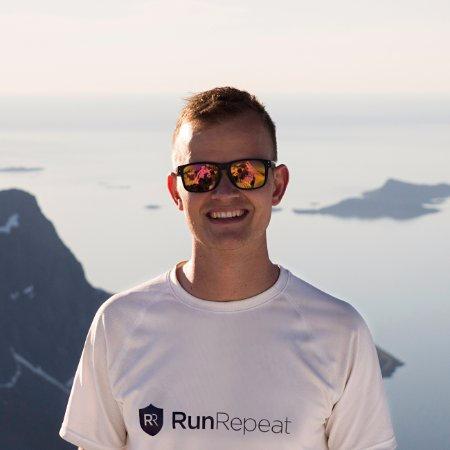Las Zapatillas De Running Caras No Son Mejor Que Las Que Son Más Asequibles De Precio (Estudio)
Based on 134,867 opinions on 391 running shoes from 24 different brands, this study contrasts the price of running shoes with the rating they have obtained. The fundamental conclusion is that expensive running shoes are not of better quality than those that are more affordable in price. In fact, cheap sneakers are better regarded than expensive ones. You can use any part of the content (graphics, comments...) as long as you reference its original source. For interviews, please contact lina@runrepeat.com /+1 817 945 66 06
First the conclusions
Based on 134,867 reviews of 391 running shoes from 24 different brands:
- The higher the price of a running shoe, the less satisfied the consumer is.
- The 10 most expensive running shoes (average price €157) obtain an average rating of 79/100. Comparing this to the 10 cheapest running shoes (average price €53, i.e. a third of that price) with an average rating of 85/100 (8.1% more).
- Specialized brands obtain 2.8% better user reviews than the best-known sports brands.
- The three most valued brands of running shoes are Skechers, Saucony and Vibram FiveFingers while the three worst valued are Reebok, Adidas and Hoka.
- The three cheapest brands of running shoes are Skechers, Vivobarefoot and PUMA, while the three most expensive are Hoka, Newton and On.
Background information
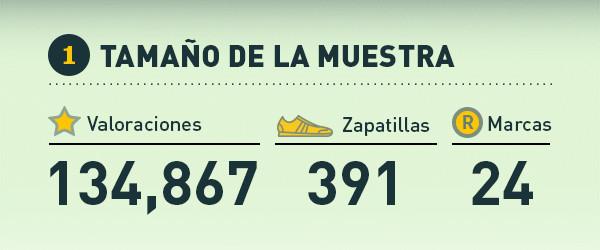
We are 100% independent. We do not recommend any running shoe, brand or store, but instead let the community of users act as a judge by giving their opinion on which running shoes are good and which ones should be avoided. “We carried out this study with the aim of spreading the message that “higher price does not necessarily mean higher quality,” says Jens Jakob Andersen, founder of RunRepeat.com, also stating that: “brands have strong incentives to promote a range of running shoes, but our study clearly proves that runners who buy expensive running shoes are less satisfied than those who buy mid-range or cheap running shoes.”
Methodology
The following process is the basis of our results: We collect 134,867 user reviews on 391 running shoes on RunRepeat We collect prices from 24 brands of the same running shoes. We contrast these two variables.
Results
The results are classified into: Footwear-specific resultsBrand-specific results.
Comparison between 391 running shoes
Below is a comparative sample between 391 running shoes using two variables: the price in US dollars on the x-axis and the average user rating of 0-100 on the y-axis. The data is represented randomly, which demonstrates the basis of our conclusion - there is no statistical correlation between the price of a shoe and the positive opinions of it. In fact, if you do a regression analysis, the data suggests that cheaper running shoes are rated more positively than expensive ones.
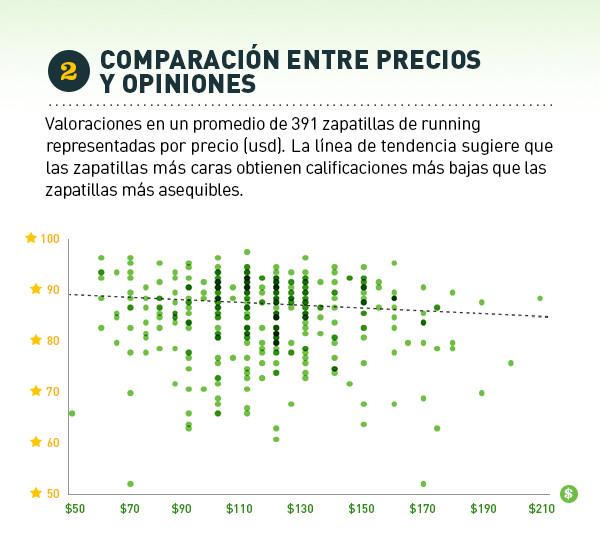
Media de opiniones de 391 zapatillas de running representadas por su precio. La línea transversal sugiere que las zapatillas de running más caras reciben apreciaciones más bajas que las zapatillas más asequibles. Al investigar a un nivel más profundo y analizar las 10 zapatillas de running más caras y las 10 zapatillas de running más baratas, los resultados obtenidos fueron sorprendentes. Las 10 zapatillas más baratas tenían un precio de 54€ con una puntuación media de los usuarios de 86 sobre 100. Si observamos nuestra lista de clasificación de zapatillas de running mejor valoradas, descubriremos que sólo el 18,9 % del total de 391 zapatillas de running alcanzan una puntuación mejor que el promedio de las 10 más baratas. En otras palabras, la zapatilla de running media mantiene una calificación peor que la barata. Además si nos fijamos en las 10 zapatillas de running más caras, que estarían destinadas a ser las zapatillas de mejor calidad y alto rendimiento, los corredores no muestran el mismo grado de satisfacción que para con las zapatillas más baratas. Con un precio tres veces más caro, las zapatillas de running de calidad suprema aparecen como calzado de corredores menos satisfechos en un 8,1% y 6,0% si se compara con el promedio de las 391 zapatillas de running. “La gente compra zapatillas de running tres veces más caras para llegar a estar un 8% menos satisfechos”, dice Jens Jakob Andersen Fundador y Presidente Ejecutivo de RunRepeat.com ¡La gente compra zapatillas caras tres veces más para acabar 8% menos satisfecha! Aquí se puede comparar los precios y las opiniones de las zapatillas más caras con los precios y las opiniones sobre las zapatillas más asequibles.
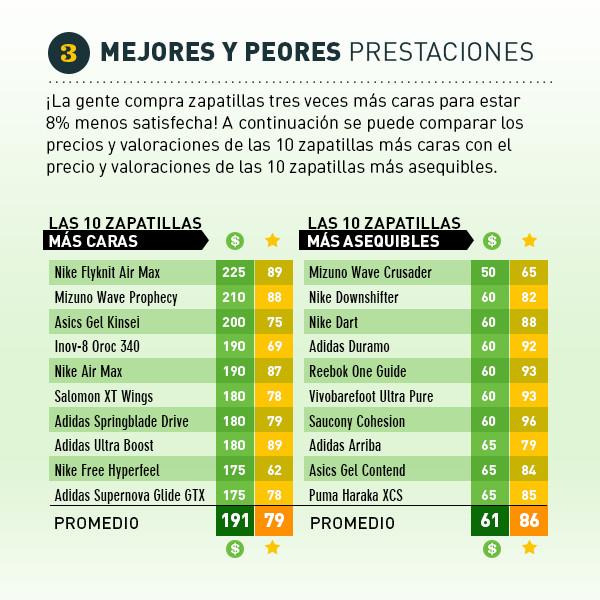
Incluso si nos fijamos en la mejor 30 zapatillas de running y en las 30 zapatillas de running peor los resultados serían los mismos. Las zapatillas de running caras están recibiendo calificaciones más bajas: "los corredores están menos satisfechos con las zapatillas de alta calidad. Soy consciente de que los precios más altos establecen expectativas altas, pero en cualquier caso el precio debería reflejar la calidad del producto y por consiguiente la valoración del consumidor "expresa Jens Jakob Andersen.
Comparación Específica de Marca: comparación de 24 marcas de calzado.
In this section we focus on the division of running shoe brands and not on specific models as indicated above. This is not promoting specific brands with good performance. We have no interests in this study other than knowledge sharing among consumers. Below you will find a graph plotting the average rating (y-axis) compared to the price in US dollars (x-axis). As with specific running shoe models, the higher the price, the lower the rating actually is. In fact, if you correlate a $50 increase in the price of a running shoe it could result in a 1.4 lower average rating for the shoe.

Average ratings and prices of 24 running shoes. Some brands are expensive, others more affordable. Some are more appreciated by runners, others less so. And some are effective in marketing and making a good product. The following graph illustrates the average user rating for each of the 24 footwear brands. "We expected that specialty brands would far outperform standard sports brands, but looking at the data, there is only a small difference. Specialty brands perform 2.8% better than sports brands overall," says Jens Jakob Andersen. Likewise, the second graph below illustrates the average prices of 24 different footwear brands. "There is nothing wrong with a company selling high-end running shoes, but I honestly think it is nonsense when a running shoe brand spends large amounts of money on marketing campaigns to promote products that consumers cannot afford. appreciate," says Jens Jakob Andersen. 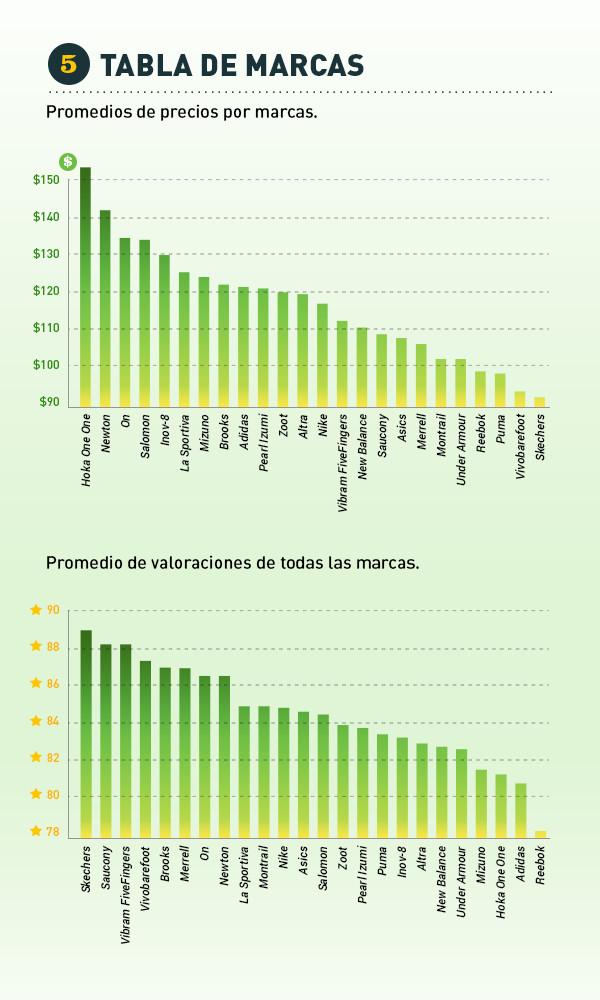
These are the most rated brands from best to worst: Skechers , Saucony , Vibram FiveFingers, Vivobarefoot , Brooks , Merrell , On , La Sportiva , Nike , ASICS , Salomon , Zoot, Pearl Izumi, PUMA , Inov-8 , Altra , New Balance , Under Armour , Mizuno , Hoka , Adidas and Reebok .
Potential biases influencing results
No study is perfect. These are some of the drawbacks of this study:
- It might be expected that if a runner buys an expensive shoe, he or she will have higher expectations for the quality of the shoe and therefore may be more easily disappointed. It is true that the more you spend, the more you expect. Therefore, the price should reflect expectations. If you are going to spend more on a running shoe, you will logically expect to get a better product.
- The opinions of information collector RunRepeat.com attract a certain type of runner, which determines the results to some extent (in both directions).
That said, we still accept our conclusions as valid and consider that potential biases have not influenced the data in any significant direction. Jens Jakob Andersen is the lead researcher behind this study. Jens is a former competitive runner and professor of statistics at the Copenhagen Business School as well as Head of the Dorte Kronborg Center for Finance Department. He is now the founder and CEO of RunRepeat.com The study was supported by Polish statistician Wojciech Fedyszyn and reviewed by dozens of experts before being published. The study was funded by RunRepeat.com
Declaration of absence of liability:
Runrepeat.com has not been influenced in any way by any brand or institution when conducting this study. The study is the result of our research and with the objective of creating transparency in the running shoe market, and not with the objective of promoting a certain use of running shoe brands. The sneaker brands have not even been aware of the development of this study. Feel free to use this content as long as you reference its original source. For interviews, please contact lina@runrepeat.com, +34 603 574 645. Below is the full infographic. It can be downloaded in 600px or 1200px . We would love to share our data if you are interested in it. Thank you.
If you only want to read ONE thing, read this
Most websites have thrown in the towel on ads promoting products that are neither wanted nor needed. At RunRepeat we refuse to give up. For this reason, you will discover that on our page there are advertisements with any inclination or preference towards this or that store, brand or shoe. Marketing budgets for brands and stores increasingly dictate which products are popular. The power of such budgets is not in accordance with what you may think. We want you to take back control over the power of choice and that's why we created RunRepeat.com, Runners' Reviews, for runners. You can also contribute and be part of the community by collaborating with your own opinion about your running shoe. Oh, and please remember...Don't buy new sneakers until yours are completely worn out. Running is more than a pair of running shoes!
